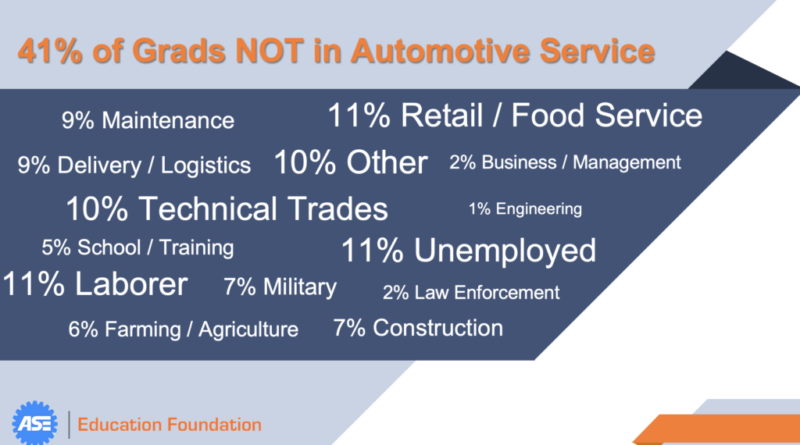Technician Shortage ‘Leaky Pipeline’
“You start with 100 graduates. Nineteen go off and do something else. Eighty-one go into the industry. But then 23 of them leave within two years, and we’re left with 58,” Coley, the president of the ASE Education Foundation said during an “ASE Virtual Instructor Training Conference” this month. “These numbers are substantial. We’re training 100 students, but after two years we only have 58 in the industry. We need to improve these numbers so we keep more of them in the industry.”
Coley was reporting on the findings of a survey of more than 3,000 current and former automotive and collision repair students the Foundation conducted this year. Nearly half (44 percent) said they felt their current training program was preparing them “extremely well” for employment, and an equal number (46 percent) said they felt at least “somewhat” prepared.
Among current students, many of the survey findings were generally positive. About 75 percent said they “probably” or “definitely” intended to pursue a career in the industry.
The 1 in 4 who didn’t plan to work in the industry listed a variety of career choices: engineering (16 percent), other technical trades, such as welding or wind power (14 percent), business management (11 percent), the military (7 percent), law enforcement (6 percent), health sciences (5 percent), construction (4 percent) or aviation (4 percent).
“There’s some pretty aspirational fields there,” Coley said. “But honestly, I’d like to see more of them say, ‘I really feel I have an opportunity in the automotive field.’”
That’s part of the “leaky pipeline.”
Among education program graduates working in the industry, many of the numbers were also good. More than 90 percent said they were “somewhat” or “extremely” well prepared by their education to work in the industry. More than half (55 percent) said they were very happy with their decision to enter the industry, and another 30 percent were at least “somewhat” happy with that decision.
The real evidence of the “leaky pipeline” is the 41 percent of automotive education program graduates who within two years of graduation were not working in the industry, Coley said. Some had pursued those “aspirational fields” like engineering (1 percent), business management (2 percent), law enforcement (2 percent), construction (9 percent), or other technical trades (10 percent).
But even more of them were unemployed (11 percent), or working in delivery (9 percent), as a laborer (11 percent) or in retail or food service (11 percent).
About 1 in 5 cited seeing better opportunities outside the industry, but the majority gave other reasons they didn’t want to stay in the industry such as pay structure or low wages, management issues, the lack of an obvious career path, or a lack of interest in the work.
“That’s a concern,” Coley said. “In some cases something drew them out: They had a better opportunity elsewhere. But in many cases, it was because we pushed them out of the automotive industry. How did we push them out? With poor salary or low wages. They couldn’t get along with their boss or coworkers. Or they didn’t enjoy the work or they lost interest. The way I look at those is if you’re not making much money and you’re not enjoying the work that you’re doing, you probably got off on the wrong foot right off the bat. You didn’t get a good start in the industry and therefore you didn’t stick.”
One way to fix the “leaky pipeline,” Coley said is to make sure more students get real “work-based learning” as part of their training program. Not just a part-time job “sweeping floors or turning oil filters,” he said, but a structured apprenticeship or co-op program with the shop and school working together to help make students “more productive when they enter industry, prepared to do more rewarding, interesting work, and justify a decent wage.”
Among those graduates working in the industry, Coley said, 62 percent said they had work-based learning as part of their training. Fewer than half (47 percent) of graduates not working in the industry after two years had a work-based learning experience.
“We think that’s a telling number,” Coley said.
There also needs to be more involvement from the industry with the schools, George Arrants, vice president of the ASE Education Foundation said, whether as an advisory committee member, a SkillsUSA judge, or even just as a guest speaker. Arrants said another survey in May of high school students in automotive training asked who had visited or presented to their class (in-person or virtually) that school year. About 40 percent said someone from a community college or for-profit automotive training program had spoken that year at the school. But only about 1 in 4 (27 percent) said someone from a local shop or dealership had presented, and even fewer (24 percent) said a former automotive student had been brought in to speak to current students.
Arrants encouraged school instructors contact their ASE Education Foundation regional field manager for help getting more industry involvement with their program.
“We want to get you the support your program needs to be successful,” Arrants told instructors. “The more industry folks on your committee, the more opportunities your students have for work-based learning, apprenticeships or internships. You’re our customer, and we’re here to help.”
More Information:
ASE Education Foundation website
https://www.aseeducationfoundation.org/
ASE Education Foundation: Collision industry ‘eating our young’
https://www.repairerdrivennews.com/2021/04/06/ase-education-foundation-collision-industry-eating-our-young/
Images: Courtesy of ASE Education Foundation
Source: https://www.repairerdrivennews.com/2021/08/24/schools-industry-need-to-work-together-to-solve-leaky-pipeline/

